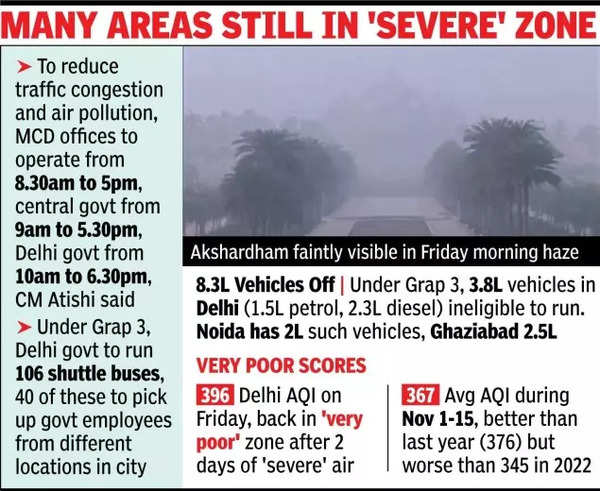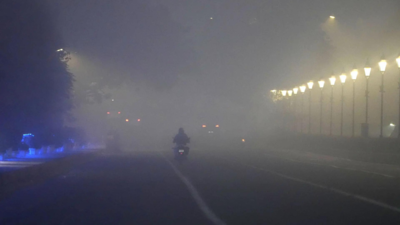NEW DELHI: After staying in the ‘severe’ category for two days, Delhi’s air quality improved marginally to the high end of ‘very poor’ on Friday, in part due to a pick-up in wind speed in the afternoon. However, air quality continued to be severe in many areas of the capital.
Meanwhile, on Day 1 of Grap 3 restrictions kicking in, Delhi government announced fresh measures to mitigate the high levels of pollution in the capital. It staggered office timings of central, city and municipal corporation staff and pressed 106 shuttle buses into service, many of these to pick up government staff from their locations.
The average air quality index (AQI), on a scale of 0 to 500, was 396 on Friday against 424 a day earlier. The improvement was slight and the city’s air continued to be hazardous at the brink of severe. In fact, the air quality was severe for most of the day, improving toward the evening owing to dry winds of up to 10km/h. At 11am, the AQI was 415, which improved to 402 by 3pm and to 388 by 6pm.
IMD said smog conditions continued almost throughout the morning. The city saw moderate fog and a further dip in temperature, which slowed pollution dispersion. The minimum visibility at Palam was 500 metres between 6.30am and 8.30am, which moderated to 600m by 9am.

Share of stubble burning in pollution rises
It was the coldest morning of the season in the city. The minimum at Safdarjung was 15.6 degrees Celsius against 16.1 on the previous day. Experts said Delhi saw variable winds of westerly and north-westerly direction bringing a cold breeze from freshly snowed Himalayan states, which impacted the city’s temperatures.
The maximum temperature too continued to fall. It was 27.8 degrees C, a notch above normal, against 29.4 degrees C recorded on Thursday. IMD expects the maximum and minimum temperatures to hover around 29 and 16 degrees Celsius, respectively.
At Safdarjung, the minimum visibility was 400m at 7am. By 8.30 am, it improved to 500 metres.
Meanwhile, according to IITM’s decision support system, the share of stubble burning to the city’s air quality was 33.33% on Thursday against 30% on Wednesday and 17% on Tuesday. It expects the air quality to slightly improve further on Saturday.
“Meteorological conditions are likely to remain extremely unfavourable for effective dispersion of pollutants. The air quality is likely to be in the very poor category from November 16, 2024, to November 18, 2024. The outlook for the subsequent six days: The air quality is likely to be in the very poor category,” a release from IITM’s air quality early warning system said.
As per DSS, on Friday, transport was the biggest contributor to local emissions, contributing 11.91% to the city’s PM2.5, while Jhajjar contributed 5.5%. According to the CPCB, the PM2.5 levels of the city oscillated between 203.4 to 227.4 micrograms per cubic metre, against national standards of 60 units and WHO’s 15 units for 24 hours. The PM10 oscillated from 350 to 371.8 per cubic metre, against the national standard of 100 units and WHO’s 45 units.
Meanwhile, in Gurgaon, the city’s 24-hour average AQI declined to 304, under ‘very poor’ category, from 321 the previous day. The monitoring station at Gwalpahari recorded the highest AQI at 368, followed by 350 at Sector 51, Teri Gram (313), and Vikas Sadan (267).
The air quality in Noida remained ‘very poor’ on Friday, with a smoky haze, lingering over Noida for the third consecutive day, becoming a serious health concern for the residents. The average AQI in the city was recorded at 323 on the day, after touching 347 on Thursday and 359 the day before.
An analysis of particulate matter levels at the city’s four air quality monitoring stations showed PM2.5 and PM10 levels were the highest in Sector 62, which is right next to the Delhi-Meerut Expressway and sees very high vehicular movement.
